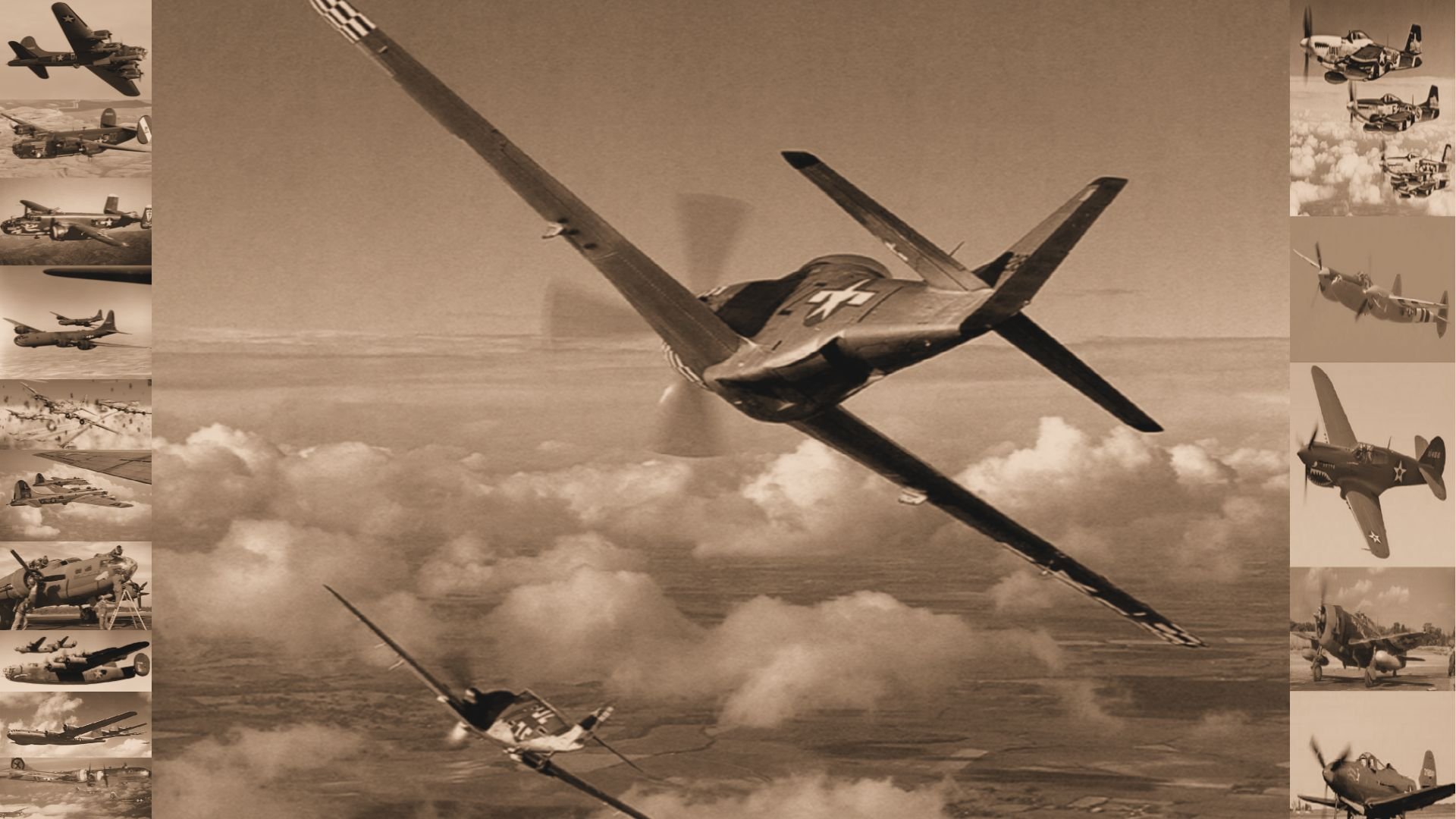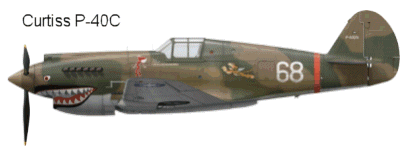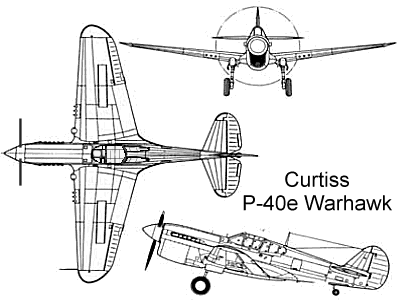 Curtiss P-40 'Warhawk'
Curtiss P-40 'Warhawk'
The Curtiss P-40 'Warhawk' was an American single-engined, single-seat, all-metal fighter and ground-attack aircraft that first flew in 1938. The Warhawk was used by almost all of the Allied powers during World War II and remained in frontline service until the end of the war. It was the third most-produced American fighter of the war.
Development
The Curtiss-Wright Corporation started designing a single-wing, fighter aircraft with radial engine, retractable landing gear and all-metal construction in 1934. The resulting aircraft they dubbed the "Hawk 75" and the American military called it the P-36 'Mohawk'. By 1937, over 1,300 had been delivered when the Curtiss-Wright Corporation decided to make a major modification by installing an Allison liquid-cooled engine. This alteration was successful and started a long series of models, the first named the P-40 'Warhawk' by the Americans. The rest of the aircraft was essentially unchanged from the P-36. By 1940, the RAF was accepting delivery of the new aircraft that they called the 'Tomahawk I'. In comparison with the Messerschmitt Bf109 or the Supermarine Spitfire it was decidedly inferior except in manouverability at low altitudes and having a tough construction. The Tomahawk was used in Britain as a trainer and an army cooperation aircraft, but it was better suited elsewhere.
Back to Top
The P-40 had good agility, especially at a dive and at medium to low altitude. It was one of the tightest-turning monoplane fighters of the war, although at lower speeds it could not out-turn the extremely maneuverable Japanese fighters such as the Mitsubishi A6M 'Zero' and Nakajima Ki-43 'Oscar'. The Allison V-1710 engines produced about 1,040 hp (780 kW) at sea level and at 14,000 ft (4,300 m) though not powerful by the standards of the time and the early P-40 variants' top speeds were unimpressive. Also, the single-stage, single-speed supercharger meant that the P-40 could not compete with contemporary designs as a high-altitude fighter. Later versions, with 1,200 hp (890 kW) Allisons or more powerful 1,400 hp Packard Merlin engines were more capable. Operational range was good by early war standards, and was almost double that of the Supermarine Spitfire or Bf 109, although it was inferior to the A6M Zero, Nakajima Ki-43 or Lockheed P-38 'Lightning'. Many versions of the aircraft were developed all in an attempt to improve the performance of the inadequate Allison engines. None of the modifications made up for this engine's lack of power and lack of a turbo charger.
Back to Top
Into Service
USAAC
A total of 15 USAAF pursuit/fighter groups (FG), along with other pursuit/fighter squadrons and a few tactical reconnaissance (TR) units, operated the P-40 during 1941-45. As was also the case with the Bell P-39 Airacobra, many USAAF officers considered the P-40 exceptional but it was gradually replaced by the Lockheed P-38 Lightning, the Republic P-47 'Thunderbolt' and the North American P-51 'Mustang'. The bulk of the fighter operations by the USAAF in 1942-43 were borne by the P-40 and the P-39. In the Pacific, these two fighters, along with the U.S. Navy Grumman F4F 'Wildcat', contributed more than any other U.S. types to breaking Japanese air power during this critical period. It was the main USAAC fighter aircraft in the South West Pacific and Pacific Ocean theaters during 1941-42. At Pearl Harbor and in the Philippines, USAAC P-40 squadrons suffered crippling losses on the ground and in the air to Japanese fighters such as the A6M Zero and Ki-43 respectively.
Back to Top
Commonwealth
The Tomahawk was sent to the Orient, India and North Africa to augment the Hawker Hurricanes. This was the common solution to inferior aircraft, even if the Japanese, Germans and Italians were flying better fighters. The RAF, Royal Australian Air Force(RAAF) and the South African Air Force(SAAF) flew them as ground-attack aircraft in support of the 8th Army in North Africa. Unfortunately, for many pilots they were also forced to use this inferior aircraft as an escort fighter for light and medium bombers against Bf109's and Macchi MC.202s. It showed up badly against both aircraft, with a high loss rate. The P-40 tolerated harsh conditions in the widest possible variety of climates. It was a semi-modular design and thus easy to maintain in the field. Though it lacked innovations of the time, such as boosted ailerons or automatic leading edge slats, it had a strong structure including a five-spar wing, which enabled P-40s to survive some midair collisions: both accidental impacts and intentional ramming attacks against enemy aircraft were occasionally recorded as victories by the Desert Air Force and Soviet Air Forces. The P-40D, named the 'Kittyhawk I' by the English, had an improved Allison engine that allowed for a shorter nose and had the fusilage mounted 0.50 caliber machine guns moved to the wings to allow for six 50 caliber machine guns that would become the standard suite of armament for all American fighters. A Packard Merlin-engined version was produced for export to Russia, but no models were received by the English, Australian or South African squadrons flying the Kittyhawk. They fought on almost every front in World War Two, from before the beginning of the Pacific war flying in China as the AVG 'Flying Tigers'. The P-40 fought as well in the Aleutians, Australia, New Guinea, India, North Africa, Italy, South Pacific and along the Eastern Front in the Soviet Air Force from the first Lend Lease aircraft to 1943 when they were replaced by La5s and Yak3s. The Kittyhawk was the main fighter used by the RAAF in World War II, in greater numbers than the Spitfire. Two RAAF squadrons serving with the Desert Air Force, No. 3 and No. 450 Squadrons, were the first Australian units to be assigned P-40s. Other RAAF pilots served with RAF or SAAF P-40 squadrons in the theater.
Back to Top
Flying Tigers
USAAF and Chinese P-40 pilots performed well in this theater against many Japanese types such as the Ki-43, Nakajima Ki-44 'Tojo' and the A6M 'Zero'. The P-40 remained in use in the China Burma India Theater (CBI) until 1944 and was reportedly preferred over the P-51 Mustang by some US pilots flying in China. The American Volunteer Group (Flying Tigers) was integrated into the USAAF as the 23rd Fighter Group in June 1942. The unit continued to fly newer model P-40s until the end of the war, achieving a high kill-to-loss ratio. Units arriving in the CBI after the AVG in the 10th and 14th Air Forces continued to perform well with the P-40, claiming 973 kills in the theater, or 64.8 percent of all enemy aircraft shot down. Aviation historian Carl Molesworth stated that "...the P-40 simply dominated the skies over Burma and China. They were able to establish air superiority over free China, northern Burma and the Assam valley of India in 1942, and they never relinquished it."
Back to Top
Soviet Air Force (VVS)
The Curtiss P-40 Tomahawk / Kittyhawk was the first Allied fighter supplied to the USSR under the Lend-Lease agreement. The USSR received 247 P-40B/Cs (equivalent to the Tomahawk IIA/B in RAF service) and 2,178 P-40E, -K, -L, and -N models between 1941 and 1944. The Tomahawks were shipped from Great Britain and directly from the US, many of them arriving incomplete, lacking machine guns and even the lower half of the engine cowling. In late September 1941, the first 48 P-40s were assembled and checked in the USSR. The Soviets stripped down their P-40s significantly for combat, in many cases removing the wing guns altogether in P-40B/C types, for example. Soviet Air Force reports state that they liked the range and fuel capacity of the P-40, which were superior to most of the Soviet fighters, though they still preferred the Bell P-39 'Airacobras'. Soviet commanders thought the Kittyhawk significantly outclassed the Hurricane, although it was "not in the same league as the Yak-1".
The P-40 was used by over two dozen countries during and after the war and was used by Brazil, Egypt, Finland and Turkey. The last P-40s in military service, used by the Brazilian Air Force (FAB), were retired in 1958 with some 13,738 of all variants being produced. Overall, the various models of the P-40 made it the second most numerous fighter aircraft produced by the Allies during WWII and it was one of the most widely recognised aircraft of World War 2.
Back to Top





